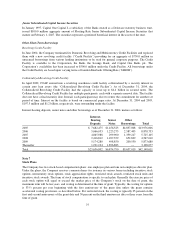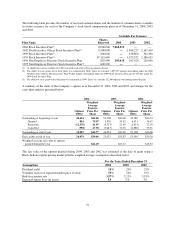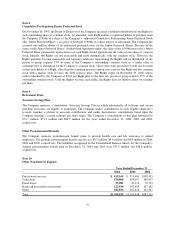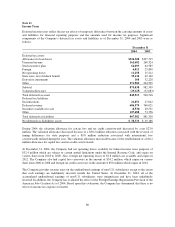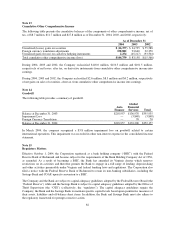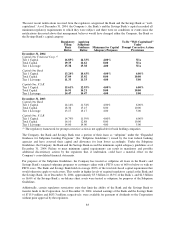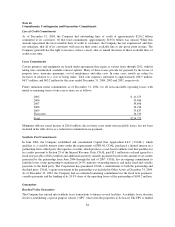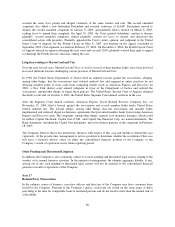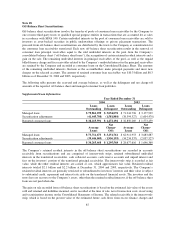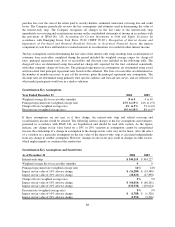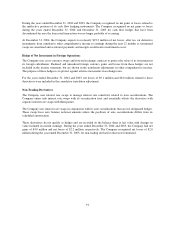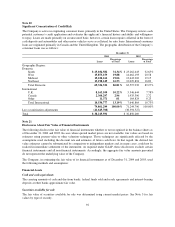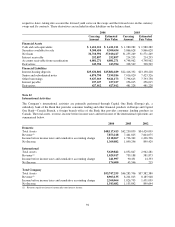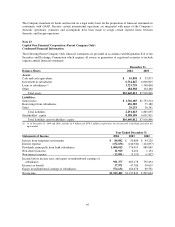Capital One 2004 Annual Report Download - page 108
Download and view the complete annual report
Please find page 108 of the 2004 Capital One annual report below. You can navigate through the pages in the report by either clicking on the pages listed below, or by using the keyword search tool below to find specific information within the annual report.and its equity is held by outside investors. In accordance with the FIN 46, these entities are evaluated to
determine whether they are variable interest entities and, if so, whether the Company is the primary beneficiary.
Variable interest entities for which the Company is the primary beneficiary are required to be consolidated.
Entities which are not determined to be variable interest and/or for which the Company is not deemed to be the
primary beneficiary are not required to be consolidated. Synthetic lease transactions, where the SPV is not
required to be consolidated, are treated as operating leases in accordance with SFAS No. 13, Accounting for
Leases.
In December 2000, the Company entered into a 10-year agreement for the lease of the headquarters building
being constructed in McLean, Virginia. The agreement called for monthly rent to commence upon completion,
which occurred in the first quarter of 2003, and is based on LIBOR rates applied to the cost of the building
funded. If, at the end of the lease term, the Company does not purchase the property, the Company guarantees a
maximum residual value of up to $114.8 million representing approximately 72% of the $159.5 million cost of
the building. This agreement, made with a multi-purpose entity that is a wholly-owned subsidiary of one of the
Company’s lenders, provides that in the event of a sale of the property, the Company’s obligation would be equal
to the sum of all amounts owed by the Company under a note issuance made in connection with the lease
inception. As of December 31, 2004, the value of the building was estimated to be above the maximum residual
value that the Company guarantees; thus, no deficiency existed and no liability was recorded relative to this
property.
Other Guarantees
In connection with certain installment loan securitization transactions, the transferee (off-balance sheet special
purpose entity receiving the installment loans) entered into interest rate hedge agreements (the “swaps”) with a
counterparty to reduce interest rate risk associated with the transaction. In connection with the swaps, the
Corporation entered into letter agreements guaranteeing the performance of the transferee under the swaps. If at
anytime the Class A invested amount equals zero and the notional amount of the swap is greater than zero
resulting in an “Early Termination Date” (as defined in the securitization transaction’s Master Agreement), then
(a) to the extent that, in connection with the occurrence of such Early Termination Date, the transferee is
obligated to make any payments to the counterparty pursuant to the Master Agreement, the Corporation shall
reimburse the transferee for the full amount of such payment and (b) to the extent that, in connection with the
occurrence of an Early Termination Date, the transferee is entitled to receive any payment from the counterparty
pursuant to the Master Agreement, the transferee will pay to the Corporation the amount of such payment. At
December 31, 2004, the maximum exposure to the Corporation under the letter agreements was approximately
$6.1 million.
Securities Litigation
Beginning in July 2002, the Corporation was named as a defendant in twelve putative class action securities
cases. All twelve actions were filed in the United States District Court for the Eastern District of Virginia. Each
complaint also named as “Individual Defendants” several of the Corporation’s executive officers.
On October 1, 2002, the Court consolidated these twelve cases. Pursuant to the Court’s order, Plaintiffs filed an
amended complaint on October 17, 2002, which alleged that the Corporation and the Individual Defendants
violated Section 10(b) of the Exchange Act, Rule 10b-5 promulgated thereunder, and Section 20(a) of the
Exchange Act. The amended complaint asserted a class period of January 16, 2001, through July 16, 2002,
inclusive. The amended complaint alleged generally that, during the asserted class period, the Corporation
misrepresented the adequacy of its capital levels and loan loss allowance relating to higher risk assets. In
addition, the amended complaint alleged generally that the Corporation failed to disclose that it was experiencing
serious infrastructure deficiencies and systemic computer problems as a result of its growth.
On December 4, 2002, the Court granted defendants’ motion to dismiss plaintiffs’ amended complaint with leave
to amend. Pursuant to that order, plaintiffs filed a second amended complaint on December 23, 2002, which
85


